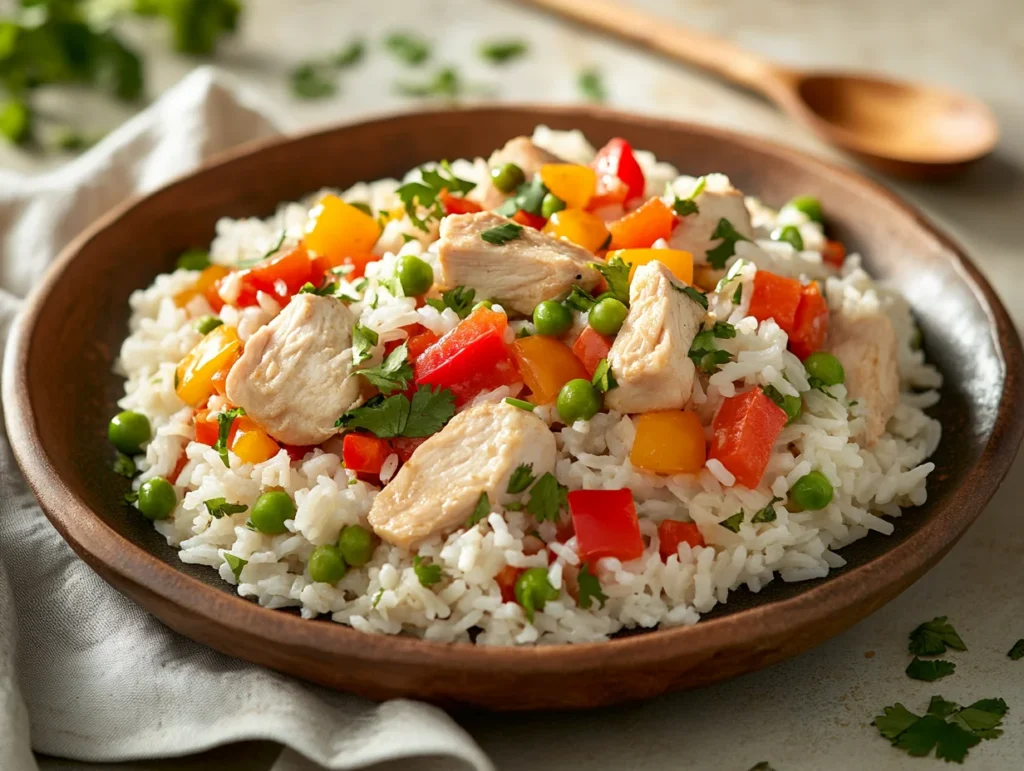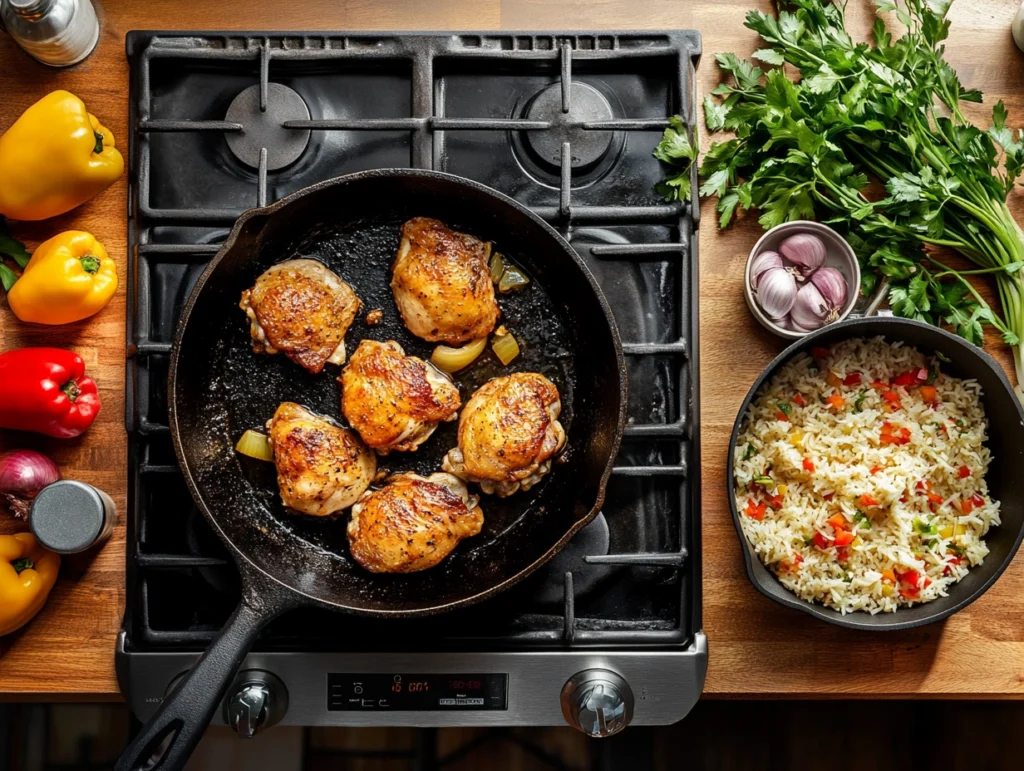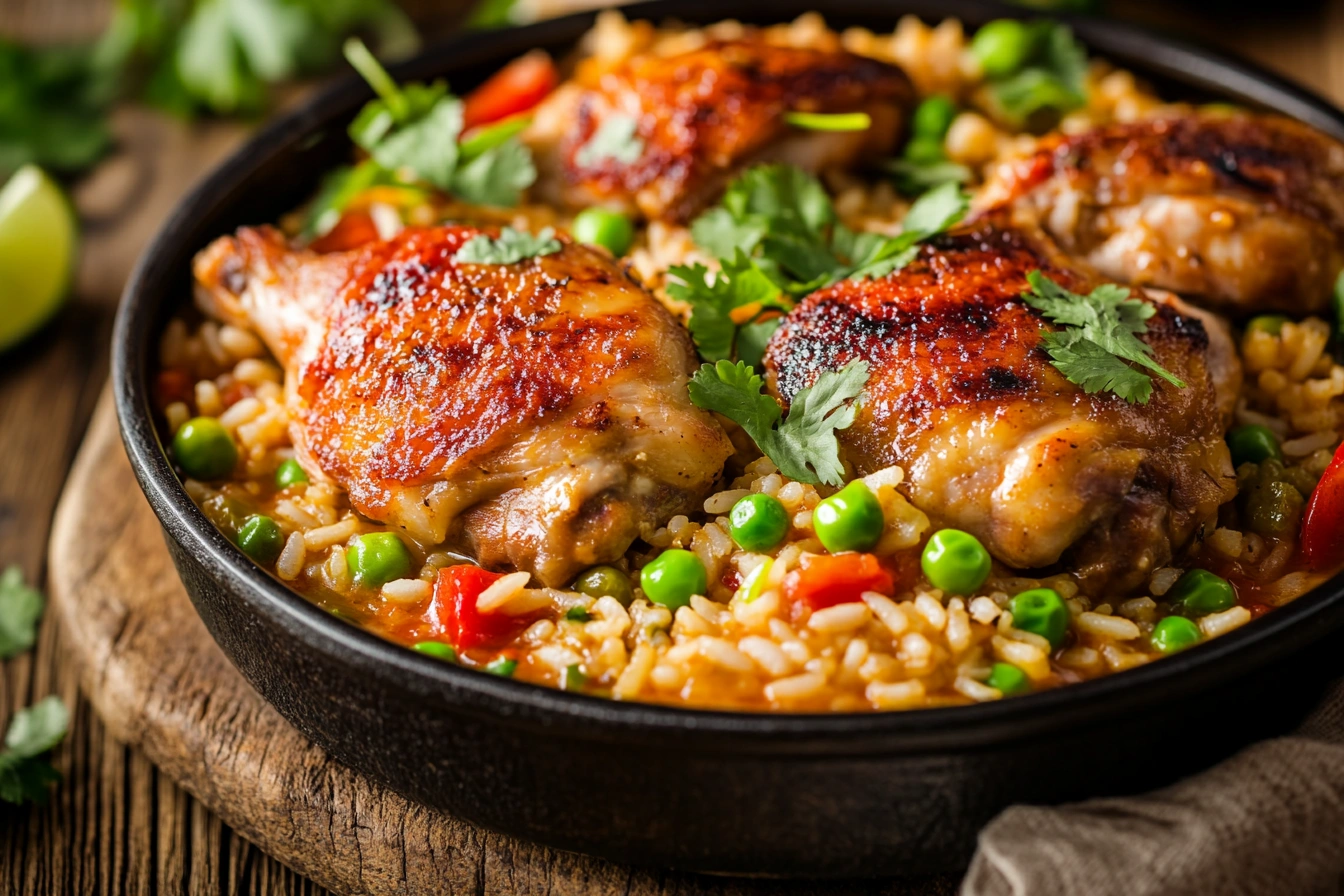There’s nothing quite like the aroma of arroz con pollo simmering on the stove, filling the kitchen with the warmth and comfort of home-cooked goodness. This traditional Latin American dish, a savory blend of seasoned rice and tender chicken, is a staple at family dinners and festive gatherings. Yet, if you’ve ever wondered, “Why is my arroz con pollo mushy?”, you’re not alone. Mushy rice is one of the most common issues home cooks face when making this beloved dish, often transforming what should be a fluffy, flavorful meal into a sticky, gloopy mess. Naturally, this problem can be particularly frustrating, especially after investing time and love into cooking.
Therefore, this article dives into the common mistakes that lead to mushy arroz con pollo and provides practical tips to help you achieve that perfect rice consistency every time. By following these tips, you’ll have the confidence to whip up an arroz con pollo that’s as authentic and satisfying as any abuela would make.
In This Guide
Understanding Arroz con Pollo and Its Texture Issues
Arroz con pollo, which translates to “rice with chicken,” is a classic Latin American dish with a rich history and many regional variations. It typically consists of chicken pieces (usually thighs and drumsticks) cooked with long-grain rice, sofrito, seasonings like Sazón and Adobo, and various vegetables like bell peppers, peas, and olives. In particular, sofrito, a fragrant blend of onions, garlic, and peppers, forms the flavor base of this dish, infusing the rice with a rich, savory taste.
Furthermore, the beauty of arroz con pollo lies in its simplicity and versatility. It can be adapted to suit different occasions, from a comforting weeknight dinner to a celebratory weekend feast. However, the dish’s success hinges on the rice’s texture. Achieving the perfect arroz con pollo means mastering the balance between tender chicken and fluffy, non-mushy rice. Therefore, to understand how to get it right, it’s essential to know what ingredients are used and how they impact the dish. For more details on the typical components of this dish, check out our guide on “What Does Arroz con Pollo Contain?”.
Common Mistakes That Lead to Mushy Arroz con Pollo

Several factors can cause arroz con pollo to turn out mushy rather than perfectly fluffy. To help you avoid this problem, here are some common mistakes that might be sabotaging your dish:
- Incorrect Water-to-Rice Ratio
One of the most frequent culprits is using too much water. When there’s excess liquid in the pot, the rice absorbs more water than necessary, leading to a soft, mushy texture. Therefore, the key is finding the correct rice-to-water ratio, which varies depending on the type of rice used. Using our guide on “The Perfect Water-to-Rice Ratio” can help you nail down this essential aspect.
- Using the Wrong Type of Rice
Not all rice varieties are suitable for arroz con pollo. For example, short-grain and medium-grain rice have a higher starch content, which makes them prone to becoming sticky and clumping together. In contrast, long-grain rice, such as basmati, is better suited for this dish as it has a lower starch content and maintains a separate, fluffy texture when cooked.
- Cooking Chicken and Rice Together Incorrectly
Arroz con pollo is a one-pot meal, but it’s crucial to manage the moisture when cooking chicken and rice together. As the chicken cooks, it releases juices, which can add extra liquid to the pot. If not accounted for, this additional moisture can oversaturate the rice. To prevent this, it’s essential to sear the chicken first to lock in its juices, then cook the rice separately or ensure the liquid levels are adjusted.
- Lifting the Lid During Cooking
Lastly, resist the urge to lift the lid while the rice is cooking. Opening the pot allows steam to escape, which can disrupt the cooking process and lead to unevenly cooked rice.
The Science Behind Perfect Rice Texture in Arroz con Pollo
To master arroz con pollo, it’s helpful to understand the science behind cooking rice. In many cases, rice texture issues often boil down to the starch content and the cooking method used. When rice cooks, two processes occur: gelatinization and water absorption. As the rice grains absorb water and swell, the heat causes the starches to gelatinize, turning the grains soft.
Starch Release and Water Absorption
First and foremost, the type of rice used plays a crucial role in determining texture. For instance, long-grain rice varieties like basmati have less starch, which helps them stay separate and fluffy when cooked. In contrast, short-grain rice releases more starch into the cooking water, resulting in a stickier texture. Therefore, choosing the right rice is vital for achieving the perfect arroz con pollo.
Balancing Rice Moisture
Another important aspect is moisture balance. If too much water is used, the rice becomes waterlogged, leading to a mushy texture. Conversely, if too little water is used, the rice can be undercooked and hard. This is why managing the rice-to-water ratio is critical. For detailed instructions on how to achieve perfect rice every time, refer to “How to Cook Rice Perfectly”.
Choosing the Right Rice for Perfect Arroz con Pollo
Choosing the right rice is one of the secrets to perfect arroz con pollo. Long-grain rice, like basmati or jasmine, is ideal for this dish because of its low starch content and ability to absorb flavors without turning mushy. As a result, these rice varieties cook up fluffy, with grains that remain distinct and separate.
Why Long-Grain Rice?
Long-grain rice is less sticky due to its lower amylopectin content, one of the starch components responsible for the sticky texture in rice. Because of this, it is more forgiving when cooked with the chicken’s juices and sofrito, maintaining the desired texture throughout the cooking process. While medium-grain rice can sometimes be used, it often produces a softer and more clumped texture, which some may find less desirable in arroz con pollo.
Rice to Avoid
Avoid short-grain and arborio rice, which are commonly used for risottos. Their high starch content makes them sticky and unsuitable for dishes where fluffy rice is key. By choosing the right rice, you set the foundation for a perfectly textured dish that will complement the savory flavors of the chicken and seasonings.
The Correct Rice-to-Water Ratio to Prevent Mushy Arroz con Pollo
The rice-to-water ratio is crucial in cooking arroz con pollo. Too much water leads to overcooked, mushy rice, while too little can result in hard, undercooked grains. As a general rule, for long-grain rice, use a 1:2 ratio—1 cup of rice to 2 cups of water. However, when cooking arroz con pollo, the chicken and other ingredients release additional moisture, so it’s advisable to use slightly less water.
For instance, if your recipe calls for 1 cup of long-grain rice, consider using about 1 ¾ cups of water or broth instead of the full 2 cups. By doing this, you allow the rice to absorb the flavors from the chicken and sofrito without becoming waterlogged, achieving that perfect fluffy texture.
Adjusting for Ingredients
If you’re adding a lot of liquid-heavy ingredients like tomatoes or broth, reduce the water content. A good rule of thumb is to let the liquid from the chicken and vegetables partially substitute for some of the water or broth you would typically use.
For more precise guidelines on the ideal water-to-rice ratio, visit “The Perfect Water-to-Rice Ratio”. By mastering the rice-to-water ratio, you’ll be on your way to creating arroz con pollo with the perfect texture.
Proper Cooking Techniques for Fluffy Arroz con Pollo

Achieving the perfect arroz con pollo requires a careful balance of cooking techniques. Here’s a step-by-step guide to ensure your rice turns out fluffy and not mushy:
1. Sear the Chicken First
Begin by searing the chicken in a hot pan. This step locks in the juices, adds flavor, and prevents the chicken from releasing too much moisture into the rice later. Remove the chicken once it has a nice golden crust.
2. Sauté the Sofrito
In the same pan, sauté the sofrito until it’s fragrant. This mixture of onions, garlic, peppers, and other seasonings is the flavor base of the dish. For more details on the importance of sofrito, read “What is Sofrito?”.
3. Toast the Rice
Add the rice to the pan and toast it with the sofrito. This step coats the rice with oil, helping to separate the grains and prevent them from becoming sticky. Toasting also enhances the flavor, adding depth to the dish.
4. Add Liquid and Chicken
Add the broth and chicken back to the pot. Remember to adjust the liquid amount to account for the moisture the chicken will release during cooking.
5. Simmer and Cook
Bring the mixture to a boil, then reduce the heat to a simmer. Cover the pot with a tight-fitting lid and let it cook undisturbed. Avoid the temptation to lift the lid, as this releases steam needed for the rice to cook evenly.
6. Let It Rest and Fluff
Once the rice is cooked, remove the pot from the heat and let it rest for 10 minutes. This resting period allows the rice to firm up and absorb any remaining steam. Gently fluff the rice with a fork to separate the grains.
How to Avoid Overcooking Rice in Arroz con Pollo
Overcooking rice is a common issue that leads to a mushy texture. The key to avoiding this is careful monitoring of cooking times and heat levels. Here are some tips to prevent overcooking your rice:
- Use a Timer: Set a timer for the recommended cooking time, usually around 18-20 minutes for long-grain rice. Check for doneness at the lower end of the time range.
- Simmer, Don’t Boil: Once the liquid comes to a boil, reduce the heat to a low simmer. Boiling can break the rice grains, releasing more starch and causing a mushy texture.
- Avoid Lifting the Lid: Lifting the lid releases steam, disrupting the cooking process. Only check the rice when you suspect it’s close to done.
- Absorption Test: After the cooking time, tilt the pot slightly to see if there’s excess liquid at the bottom. If there is, cook for a few more minutes uncovered.
Following these steps ensures that your rice reaches the perfect doneness, avoiding that dreaded mushiness.
Traditional Arroz con Pollo Preparation Tips
Traditional preparation methods for arroz con pollo often emphasize the importance of sofrito, the cooking vessel, and patient simmering. Here are some tips rooted in tradition:
- Use a Caldero: A heavy-bottomed pot like a caldero or Dutch oven ensures even heat distribution, crucial for cooking rice evenly.
- Cook with Sofrito: Sofrito provides the dish’s signature flavor and impacts rice texture. Cooking the rice with sofrito and oil coats the grains, helping them stay separate.
- Control Moisture with Sofrito: When using sofrito, balance the liquid content to avoid adding too much moisture to the dish.
Fixing Mushy Arroz con Pollo: A Step-by-Step Guide
If your arroz con pollo has turned out mushy, don’t worry—there are ways to salvage it:
1. Drain Excess Liquid
If there is still water at the bottom of the pot, carefully drain it off using the lid to prevent spilling the rice.
2. Spread and Dry
Spread the rice on a baking sheet and place it in a low oven (around 250°F) for 5-10 minutes. This method helps evaporate excess moisture, drying out the rice slightly.
3. Fluff the Rice
Gently fluff the rice with a fork to separate the grains. Be careful not to stir too vigorously, as this can break the grains and make them stickier.
4. Adjust Cooking in Future Attempts
For your next attempt, adjust the rice-to-water ratio, reduce the cooking liquid, and monitor the cooking time more closely.
With these steps, you can salvage your arroz con pollo and use the experience to improve your technique for next time.
Common Questions About Cooking Arroz con Pollo
1. Can I Use Different Cuts of Chicken?
Yes, you can use various cuts, but thighs and drumsticks are preferred for their flavor and tenderness. Breasts can be used, but they may dry out more quickly.
2. How Do I Reheat Arroz con Pollo Without Making It Mushy?
Reheat the dish in a covered pan over low heat with a splash of water or broth to add moisture without overcooking the rice.
3. What Can I Substitute If I Don’t Have Sofrito?
You can use a blend of onions, garlic, and bell peppers sautéed in olive oil as a substitute, though it won’t have the same depth of flavor as traditional sofrito.
These FAQs cover some of the most common questions, helping you troubleshoot and customize your arroz con pollo.
Enhancing Flavor While Maintaining Texture
To boost the flavor of your arroz con pollo without compromising the texture, use broth instead of water when cooking the rice. By using broth, you infuse the rice with a rich flavor, making it more savory and aromatic. Additionally, adding Sazón seasoning or a bay leaf can enhance the dish’s flavor profile, giving it that authentic touch.
Furthermore, marinating the chicken with lime juice, garlic, and spices before cooking deepens the flavor without adding extra moisture to the rice. For best results, ensure that the chicken is thoroughly seared to lock in its juices and prevent them from leaking into the rice during cooking.
By focusing on seasoning methods that don’t add excess liquid, you can enhance the dish’s flavor while maintaining the ideal rice consistency. This way, you’ll have a flavorful arroz con pollo that’s both delicious and perfectly textured.
Using a Rice Cooker or Instant Pot
While arroz con pollo is traditionally made on the stovetop, modern kitchen appliances like rice cookers and Instant Pots can simplify the process. Here’s how to use them effectively:
Rice Cooker
- Adjust Water Ratio: Use less water than usual since the rice cooker retains more steam.
- Layer Ingredients: Place the chicken on top of the rice to allow the juices to infuse without oversaturating the grains.
Instant Pot
- Use the Sauté Function: Sear the chicken and sauté the sofrito using the sauté setting before adding rice and liquid.
- Quick Release: After pressure cooking, use the quick release method to prevent overcooking.
Using these appliances can make the cooking process more hands-off while still achieving delicious results.
Arroz con Pollo Variations and Their Impact on Texture
Arroz con pollo has many variations across Latin America, each adding unique touches that can affect rice texture. For example:
- Cuban Version: This version often includes beer and wine, adding extra liquid and depth of flavor. To avoid mushy rice, you’ll need to adjust the water ratio accordingly. Incorporating beer and wine can create a richer taste, but balancing the liquids is key to maintaining the rice’s ideal consistency.
- Puerto Rican Style: This style uses annatto oil for its vibrant color and often includes olives and capers. These ingredients contribute to the dish’s savory flavor without affecting the rice’s texture. As a result, the rice remains fluffy and separate, while the olives and capers add a deliciously briny taste.
Experimenting with these variations can be exciting, but remember to adjust the cooking process to maintain the ideal rice consistency. By carefully managing the ingredients and liquids, you can explore different regional flavors while ensuring that your arroz con pollo turns out perfectly every time.
Key Takeaways: How to Avoid Mushy Arroz con Pollo
To prevent mushy arroz con pollo, keep these key tips in mind:
- Choose the Right Rice: Use long-grain rice for the best texture.
- Manage Moisture: Use the correct rice-to-water ratio and account for moisture from the chicken and sofrito.
- Monitor Cooking: Avoid overcooking by simmering rather than boiling and not lifting the lid during cooking.
- Fluff and Rest: Let the rice rest after cooking and fluff it gently to separate the grains.
By following these guidelines, you’ll be on your way to mastering this beloved dish with perfectly cooked rice every time.
Conclusion
Cooking arroz con pollo is a journey into the heart of Latin American cuisine, filled with rich flavors and comforting aromas. Although mushy rice can be a common hurdle, understanding the balance of ingredients, techniques, and cooking methods can lead to a dish that’s both delicious and satisfying. By applying the tips and tricks shared in this guide, you’ll be able to create arroz con pollo that your family and friends will love.
Ready to put these tips into practice? Check out our detailed recipe for the traditional “Arroz con Pollo Puerto Rican Chicken and Rice Recipe” to start cooking with confidence.
Additional Recipe Recommendations
If you enjoyed learning about arroz con pollo, you might also love trying other chicken-based dishes that highlight perfect cooking techniques. For a delicious lunch option, check out our “Perfect Grilled Chicken Wrap Guide”. This guide will show you how to achieve juicy, flavorful chicken for a variety of dishes, giving you the confidence to create meals that are both tasty and satisfying.
Explore More Recipes
- Latin Chicken and Rice Dish Variations: Explore different ways to bring a Latin twist to your meals. From incorporating unique spices to using diverse cooking methods, these variations will add new and exciting flavors to your culinary repertoire.
- Healthy Dinner Options: Find balanced and nutritious recipes for your family dinners. Whether you’re looking for lighter fare or hearty comfort food, these options ensure that every meal is both wholesome and delicious.
Happy cooking, and remember, every kitchen mistake is just a step toward mastering your favorite dishes!

